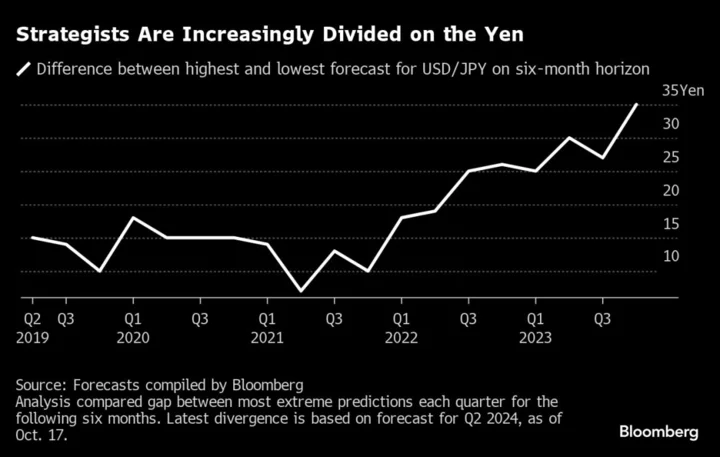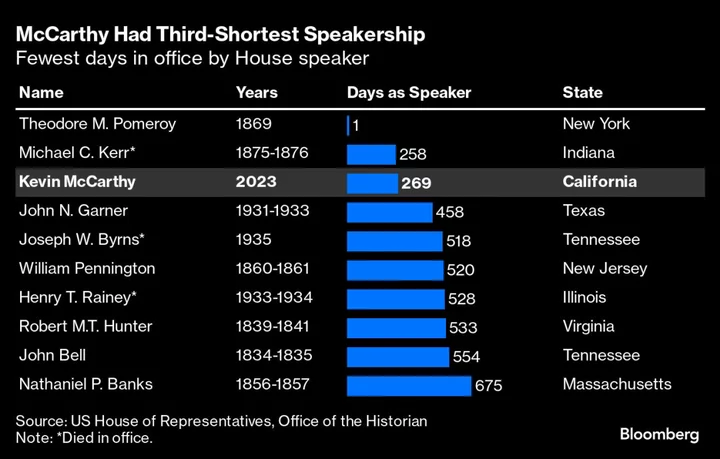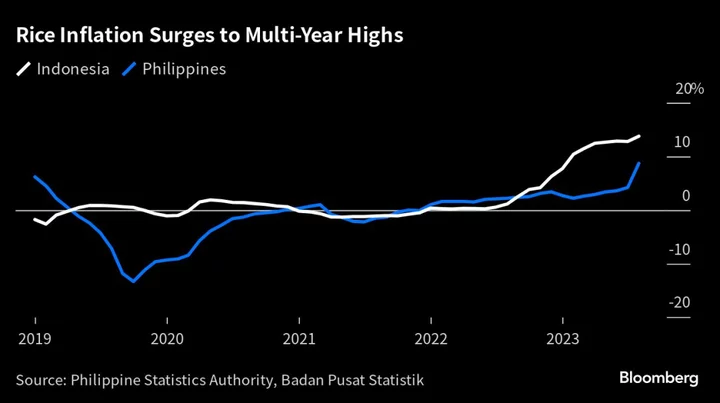A chasm is opening up on Wall Street over the direction of the yen.
On the one side: Goldman Sachs Group Inc., Mizuho Americas, JPMorgan Chase & Co., and Bank of America Corp., who see Japan’s currency hitting its weakest level in more than 30 years. On the other? Seemingly everyone else. The median forecast for the yen sees it at 140 per dollar by the end of the first quarter and 130 for the end of 2024.
Indeed, analysts are now the most divided since 2016, according to an analysis of currency forecasts compiled by Bloomberg that compared the high and low predictions each quarter for the following six months.
At the heart of their disagreement is division over the outlook for the US economy and the implications of that for the US dollar, the most traded currency against the yen. Those who see the Federal Reserve keeping interest rates high expect the dollar to strengthen at the expense of the yen. By contrast, many of the firms looking for a surge in the yen see a US recession, and weaker dollar, as inevitable.
That may seem ironic, given how much ink has been spilled debating when the Bank of Japan will tighten its ultra-loose monetary policy and the nation’s capacity for currency intervention. Yen bears argue it’s the dollar’s path that truly matters.
“It’s probably more what will happen in the US that will change the yen dynamics than what the BOJ will do,” said Johan Gade, chief executive officer of Saxo Bank Japan.
“You can see intervention was done last year at around the 150 level, but now we are back to around the 150 level,” Gade said. “So from a long-term perspective, those interventions have a limited lifetime unless they are followed up with the real driver of the weakness, which is the interest rate difference.”
That gap is now near the widest in over 20 years thanks to the most aggressive Fed tightening cycle in a generation, which stands in contrast to the BOJ continuing with its negative policy rate. As a result, US Treasury yields have soared, boosting the dollar against low yielders like the yen.
It’s that dynamic that has Bank of America betting on further yen weakness. The Japanese currency is too closely tied to the US central bank’s own policy cycle to do anything but move lower, according to BofA strategists. “Until we see increasing odds of the Fed’s rate cuts, the yen weakness is likely to persist,” said Shusuke Yamada, head of Japan currency and rates strategy at the bank.
BofA expects the yen to trade to 155 per dollar by the first quarter. That’s also the level flagged by a former top forex official as when the government will “start to worry.”
It was around 149.80 during morning trading in Tokyo on Wednesday.
In contrast, Citi FX strategists are among the most bullish. They see the yen gaining to 130 per dollar six to 12 months from now. Their view is predicated on a recession in the US that will finally drag down yields, plus some level of BOJ tightening, Dirk Willer, the firm’s head of global macro and EM strategy, said.
The other possible driver of a yen rally — BOJ action to tighten monetary policy — remains clouded in uncertainty. There are increasing indications that the central bank may raise its inflation forecasts at the end of this month, but it is difficult to judge if this will prompt a tweak from the BOJ anytime soon. Economists expect the -0.1% policy rate to be kept at that level until late next year, according to a survey by Bloomberg.
There have been few concrete efforts to influence the value of the yen so far this year after Japanese officials intervened last fall; while some thought a surge in the Japanese currency directly after it touched 150 per dollar in early October was evidence of intervention, officials have declined to confirm. The gains in the currency were short-lived and the yen has gradually slipped lower.
On Monday, Japan’s top currency official, Masato Kanda, said that as a general principle, rate hikes are one way nations respond to capital outflows, adding that action is taken when currency moves become excessive.
Such rhetoric means traders are left to bet on the yen through the lens of the Fed’s rate cycle. Expectations of whether the US central bank will hike again this year — and when it will start to cut rates as growth slows — have vacillated, rising as high as 50-50 chance in recent days.
“It’s ultimately a very close call at this point, but the broader issue is what level of rates and financial conditions do we really need here to cool economic activity and ensure that inflation is back to target,” Tiffany Wilding, an economist at Pacific Investment Management Co., recently said on Bloomberg Television. “The bond market and the Fed are still searching for that level.”
There’s a lot hanging on whether strategists make the right call. After a surge in the yen at the end of last year wrongfooted forecasters, many came into 2023 expecting gains. Instead, the currency has weakened against all of its Group-of-10 counterparts and is already down more than 12% against the dollar since January.
“I have to acknowledge that we were in that camp which thought that the yen would do better this year considering a policy peak in the US, and the notion that Japan is almost inevitably going to have to adjust its own of course of normalization,” said Aninda Mitra, a macro and investment strategist at BNY Mellon Investment Management in Singapore.
Mitra sees room for the yen to turn around early next year. Although, he warns, the currency could weaken to 155 should the Fed opt to hike the US benchmark rate again.
--With assistance from Winnie Hsu.
(Updates with inflation outlook for Japan, survey of economists on BOJ’s negative policy rate, and yen level versus dollar on Wednesday.)
Author: Mia Glass, Carter Johnson and Anya Andrianova









